Cat behavior training means teaching and modifying your cat’s behavior to respond to specific commands, behave correctly in particular situations, and eliminate undesirable behaviors.
Common cat problems can include destructive behaviors, excessive vocalization, aggression, urine marking, scratching, and chewing. Fortunately, you can use positive reinforcement methods to train your cat to behave more appropriately, respond to certain commands, and even perform simple tricks!
Read this guide about common cat behavior training problems and issues and learn how to train your cat using positive reinforcement tips and tricks.
What Are The Common Cat Behavior Problems?
The common cat behavior problems are outlined below.

Scratching
Cats love to scratch! Your cat will scratch while playing, while stretching, to mark territory, or to give a threatening signal to other cats. In addition, your cat’s claws need regular sharpening, and she will scratch on things to remove worn or frayed outer claws, exposing the new sharper ones beneath.
Unfortunately, all that scratching causes lots of damage to your furniture, drapes, and floor coverings!
Chewing
Cats chew things for several reasons, including:
- Teething
- Exploring their environment
- Play
- Stress relief
- Dental health
Chewing can also be a sign of anxiety or discomfort, so be sure to seek veterinary advice if your cat’s chewing behavior persists.
Urine Marking
Unneutered male cats are usually responsible for urine marking, and they do it to mark territory or communicate with other cats. Urine marking generally involves spraying small amounts of pee on vertical surfaces, such as your walls or chairs.
Aggression

Aggression in cats can be distressing and dangerous if you have small kids in your household. Fortunately, you can use plenty of strategies to overcome and fix aggressive cat behavior, including visiting a cat behaviorist for advice.
Obsessive-Compulsive Licking
Although it’s normal for cats to spend half their day grooming themselves, obsessive-compulsive licking can indicate a problem.
Cats overgroom for several main reasons, including stress, boredom, pain, allergy relief, and infection.
Vocalization
Some cats meow excessively, which can drive you crazy, especially if the behavior happens at night.
Your cat might vocalize because she is in pain, her other senses are failing, or she has dementia. Aggression, frustration, and anxiety can also cause cats to vocalize excessively and repeatedly.
What Are Some Weird/Uncommon Cat Behaviors?
Some weird or uncommon cat behaviors include the following:

Bouncing Off The Walls
Bouncing off the walls, also known as the “zoomies,” is a form of overexcitement that simply means your cat is feeling good.
Head Bumping
Head bumping and rubbing on their owners is simply a form of marking.
Chattering and Chirping
Chattering and chirping happen when your cat is happy and excited at a hunt or game prospect.
Chewing “Weird Things”
Chewing “weird things” is your cat’s way of exploring something unfamiliar.
Napping In Tight Places
Napping in tight places helps your cat feel safe, secure, and less vulnerable while he’s sleeping.
Giving Gifts
Giving gifts, such as a mouse or bird, happens when a cat brings home its prey to a place she feels secure, comfortable, and safe. She might also want to share her prize with you, too!
Ignoring You
Ignoring you is your cat’s way of telling you she feels threatened or stressed.

Kneading or Treading
Kneading and treading are your cat’s way of telling you she feels happy, relaxed, and comfortable.
Knocking Things Over
Knocking things over is your cat’s way of getting your attention or simply playing.
Nibbling On Plants
Nibbling on plants and grass in your home or garden can be a sign of stress, an indication of abdominal discomfort, or simply the cat’s way of exploring her environment.
Pooping Outside The Box
Pooping outside the litter box can happen due to stress, health problems, a dirty litter box, changes in the household, the litter box in the wrong place, or the arrival of a new pet.
Sipping From The Faucet
Sipping from the faucet simply shows that your cat prefers fresh, cool water to that stale stuff in their dirty water bowl that probably needs cleaning!
Sleeping On Your Laptop
Sleeping on your laptop is your cat’s way of keeping warm at night or on cold days.
Staying Up All Night
Staying up all night is quite normal for many cats. Cats are naturally nocturnal, often waking at night to go cruising the neighborhood while you’re sleeping.
Rolling Over
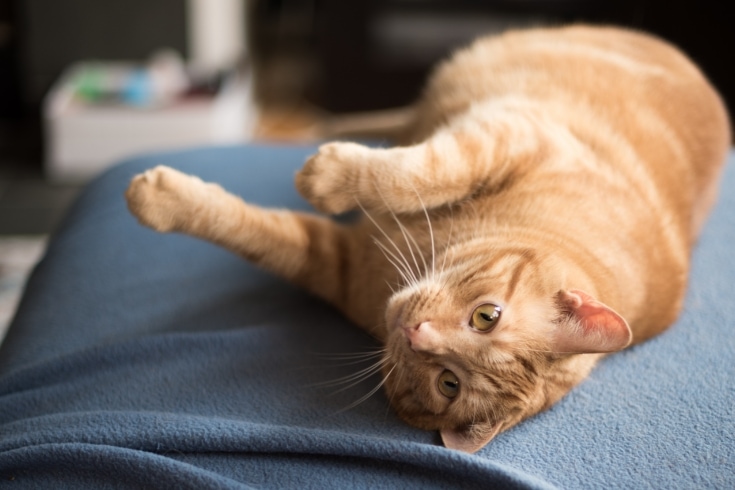
Rolling over means your cat is feeling playful or wants to stretch out after a nap.
Presenting It’s Butt
Presenting its butt is just your cat’s weird way of showing you her affection. Don’t panic; it’s just a cat thing!
Covering Poop
Covering poop is a normal cat behavior to hide its scent from predators or to show that they’re not a threat to an “alpha” cat in the household.
Covering Food
Covering food is called “caching” and is something wild cats do to save leftover food for later or keep the meat cool and fresh.
Eating Plastic
Eating plastic is known as “pica,” or a desire to eat non-edible things. Stress, curiosity, health issues, or a lack of nutrients in the diet usually cause this behavior.
Eating Grass Leaves and Plants
Eating grass, leaves, and plants can be a sign of stress, an indication of abdominal discomfort, or simply the cat’s way of exploring her environment.
Sneering
Sneering is more correctly called the Flehmen response. It happens when the cat curls her lip to allow her tongue to trap scents against the vomeronasal organ in the roof of the mouth.
Winking

Winking is a sign of affection and trust between you and your pet.
Interrupting Phone Calls
Interrupting phone calls most likely happens when your cat is curious about your phone’s noises.
Sitting In Boxes
Cats sit in boxes because they like the security provided by the enclosed space.
Licking You
Licking you is a sign of affection and bonding.
Running Away From Plastic Bags
Running away from plastic bags is thought to be a natural response to what sounds like a snake rustling through the grass or could be because the cat has been shooed away from a trash can previously.
Farting
Farting is usually caused by a digestive disorder, food allergy, or swallowing too much air when eating.
Sucking Wool
Sucking wool is usually related to separation anxiety and is the feline equivalent of nail-biting or thumb-sucking in humans.
Staring
Staring can be a sign of a close bond between you and your cat, as she won’t hold eye contact with someone she doesn’t like or trust.
What Are The Things You’ll Need For Training?
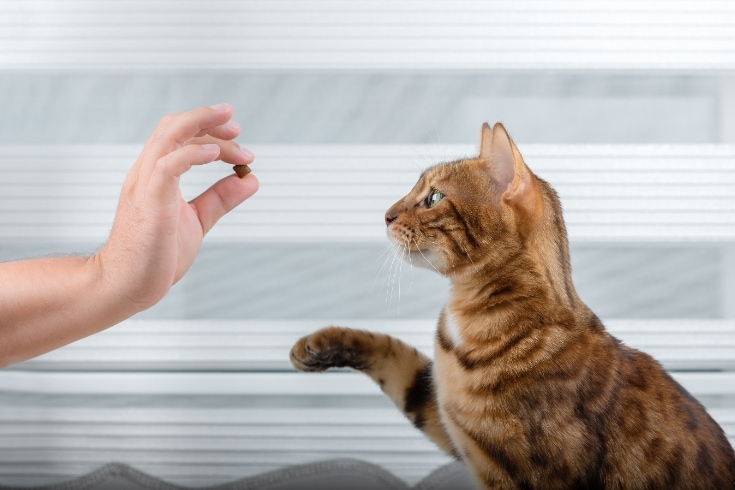
Training your cat can be made much easier if you have the following tools in your armory:
A Clicker
A clicker device is a small handheld gadget that makes a clicking sound when you press it and is used during positive reinforcement training when the cat exhibits a desired behavior in response to a command.
Click immediately if the cat responds as you want it to, and reward the behavior with a treat or praise.
A Target Stick
A target stick is a tool that you can use to move your cat from place to place without physical intervention. In cat training, the target stick provides a clear visual target to move the cat from one place to another.
Treats
Treats are food rewards given to a cat to reward desired behavior.
Food Pouch
A food pouch is a small container that’s used to hold treat rewards rather than using your pocket.
Scratching Mat
A scratching mat is a mat made from sisal or coir that the cat uses to sharpen her claws rather than using your furniture!
Cat Training School Membership
Taking your cat to training school can be an excellent way of socializing your feline friend and allows you to swap notes and training tips with other cat owners at training classes.
Cat Carrier
A cat carrier is a fabric, wire, or plastic container used to safely transport your cat in your car when making vet and groomer visits and the like.
You’ll find all these items readily available in your local pet store.
Is It Possible To Train A Cat To Behave?
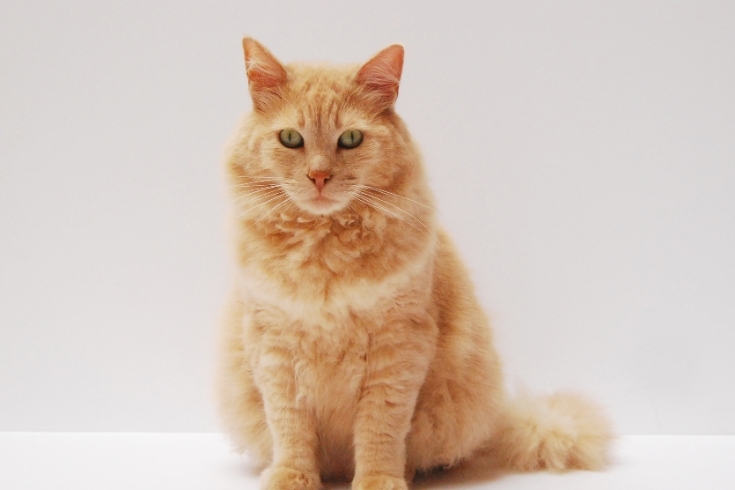
Can you train a cat to behave?
Yes, just like dogs, it is absolutely possible to train your cat to behave how you want her to.
The key to successful cat training is positive reinforcement. That means rewarding your pet with toys, treats, petting, or whatever your cat prefers to receive when she does what you want to reinforce that good behavior.
How To Train Cats To Behave
Cat behavior training involves using a combination of consistent routines, positive reinforcement, and understanding your feline friend’s natural behaviors.
Here’s a quick how-to guide on cat behavior training.
- Start by teaching your cat basic commands like “sit,” “stay,” and “come.” Use treats and plenty of praise to encourage your cat to follow your verbal cues.
- Cats respond best to positive reinforcement training methods. That means rewarding your cat with treats, praise, toys, or playtime whenever she behaves in the way you want her to. That encourages your cat to repeat the desired behavior in the future.
- Sometimes, establishing a consistent routine for feeding, grooming, and playtime helps to make your cat feel more secure and reduces any undesirable behaviors that might arise from stress or insecurity.
- Provide your cat with scratching posts and mats, toys, perches, and vertical spaces for climbing. That helps to redirect the cat’s natural Instincts and prevents destructive behaviors from developing.
- If your cat exhibits unwanted behavior, you can use safe deterrents, such as double-sided tape and pet-safe deterrent sprays.
- Never punish your cat! Punishment is not an effective training cat training method and usually makes your cat resentful and afraid of you. Instead, focus on positive reinforcement and reward-based training to encourage your cat to repeat desirable behaviors.
- Clicker training entails using a clicker device to indicate good behavior, followed immediately by a reward and can be highly effective in training your cat.
- Use several short training sessions every day rather than one long one so your cat doesn’t get bored.
Individual cats learn at different rates, so be consistent and patient in all your training so that your cat has plenty of time to understand and learn.
How To Train A Cat To Stop Meowing
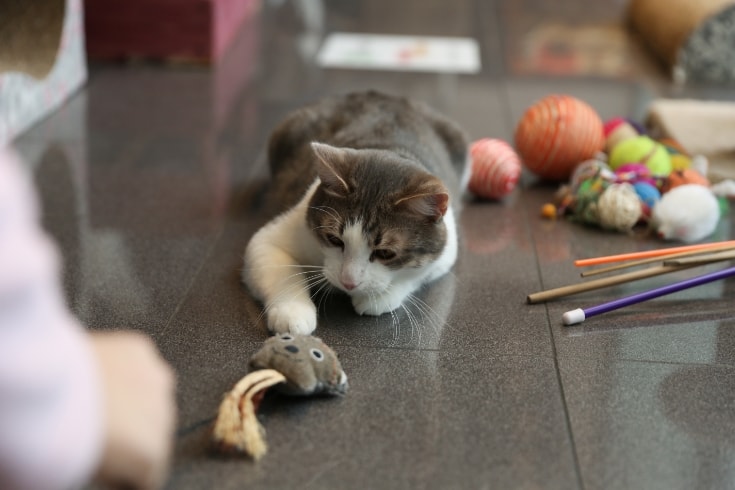
Training a cat to stop vocalizing can be difficult because meowing is a natural communication method for cats. However, here are a few tips to train your cat to stop meowing.
- Sometimes, excessive meowing indicates an underlying health condition, so you should have your cat checked over by a vet before assuming the problem is behavioral.
- Your cat could be meowing out of boredom, so ensure she has plenty of toys, puzzle feeders, scratching posts, and the like to keep her busy and physically and mentally satisfied.
- Your cat will appreciate a daily routine and that can often reduce problem meowing. Feed and groom your kitty at the same times each day and include regular training and playtime sessions too.
- Some cats meow to seek attention, and it’s essential you don’t acknowledge the behavior and reinforce it by responding every time. If you ignore your cat’s meowing, she will quickly learn that her excessive vocalization won’t get her what she wants. Only give your cat your attention when she’s calm and quiet.
- Whenever your cat is quiet, reward her with treats, playtime, or praise. Positive reinforcement helps to show your cat that staying quiet will get her the rewards and attention she wants.
- Sometimes, providing your cat with a peaceful, calm environment can remove the anxiety triggers that are causing her excessive meowing.
- If your cat’s meowing is stress-related, using a pheromone product can help to calm your pet and reduce her vocalization.
Always be patient when working with your cat; consult your vet for advice if the undesirable behavior persists.
How To Teach A Cat To Stop Biting
Teaching your cat to stop biting demands patience, positive reinforcement, and a consistent approach. Here’s how to do it.
- When your cat bites, redirect her attention immediately to a toy to show her that biting you is not acceptable, whereas biting her toys is okay.
- Don’t use your hands or feet when playing with your cat, as that can encourage her to bite you. Instead, stick to using toys that keep your cat’s teeth well away from your skin.
- If you can socialize your cat from a young age, she will be less likely to bite in the future. Encourage your family to handle the cat gently, practice putting your cat in her cat carrier, and reward her with a treat for calm behavior.
- Always use positive reinforcement when training your cat not to bite you. Positive reinforcement encourages good behavior that will eventually replace undesirable biting.
- As soon as your cat sinks her teeth into you, make a loud noise like a yelp to imitate the sound a littermate would make if play biting got out of hand. Ignore your cat until she calms down to show her that biting leads to your withdrawing your attention.
If you struggle to stop your cat from biting you, seek professional help from your vet or an animal behaviorist.
How To Train Your Cat Not To Scratch Furniture
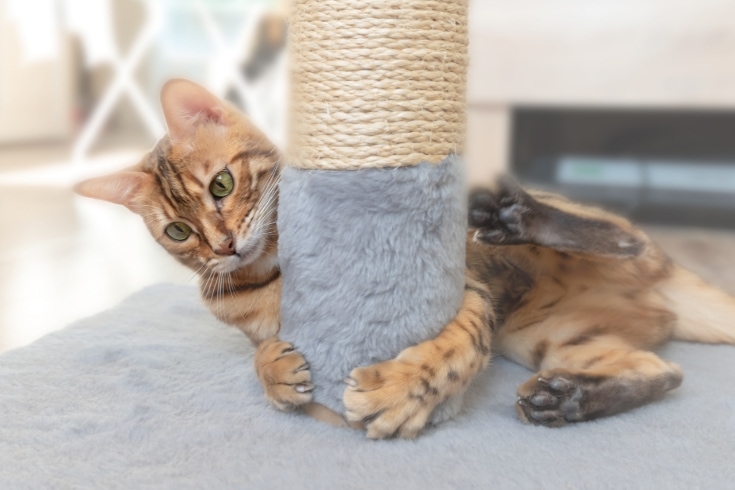
It isn’t easy to train your cat not to scratch furniture, but it can be done with patience and a consistent approach.
- It’s natural for your cat to want to scratch things, so you need to give her an alternative to your furniture, such as a scratching post or mat, and place it close to the furniture.
- Cover the furniture with aluminum foil, double-sided tape, or something else that cats dislike. The cat will gradually learn to avoid the furniture, even once you’ve removed the deterrent.
- When your cat uses her new scratching mat, reward her immediately with treats carried in a food pouch or praise. That positive reinforcement encourages the cat to keep using the scratching post rather than your furniture.
- If you catch your cat scratching the furniture, try quickly and gently lifting her up, putting her near the scratching mat, and encouraging her to use that instead.
- Trim your cat’s claws regularly to keep her from damaging the furniture. If you’re not confident about clipping your cat’s claws yourself, ask your vet or a pro groomer to do it for you.
- It can be effective to use commercial deterrent products on your furniture. These products produce a smell that cats find unpleasant, are easy to apply, and are harmless to your cat and your furniture.
Never punish your cat if you catch her scratching your furniture. Punishment will make your cat afraid of you and will not be an effective deterrent anyway.
How To Train An Aggressive Cat
Aggressive behavior in cats can have multiple causes, including territoriality, pain, fear, or previous negative experiences. Before you try training your cat not to be aggressive, have a chat with your vet to make sure your cat doesn’t have any medical conditions that could be causing the aggressive behavior.
Here are a few tips on how to train an aggressive cat.
- Provide your cat with a safe, secure place where she can rest and hide when she wants to. That can help reduce aggressive behavior associated with fear.
- Watch your cat to identify what triggers the aggressive behavior. Once you know what’s upsetting your pet, you can work on ways of preventing or avoiding those situations.
- When your cat is calm and non-aggressive, use positive reinforcement techniques, such as praise and rewards, to show her that she’s behaving correctly and encourage her to repeat the desired behavior.
- Have interactive playtime sessions using a target stick or fishing pole toy to redirect your cat’s energy and give her a natural hunting game to enjoy.
- If your cat becomes aggressive toward other animals and people, you need to work on socializing her by introducing them gradually, in a controlled environment, using positive reinforcement, and rewarding calm behavior.
An aggressive cat is potentially dangerous to other animals and to you and your family. If your cat’s aggressive behavior persists, I recommend you discuss the problem with your vet or an animal behaviorist.
Can Cats Learn Through Positive Reinforcement?

Yes, your cat can learn through positive reinforcement!
Positive reinforcement training means using rewards to increase the likelihood of a desired behavior recurring. Good rewards for cats include treats, petting, toys, catnip, and interactive play.
How To Give Positive Reinforcement
Here’s a step-by-step guide on how to give your cat positive reinforcement.
- Whenever your cat behaves in a desirable way, offer her some of her favorite treats to reinforce good behavior.
- Cats respond to their owner’s voice, so you can use a positive, cheery tone when praising your cat for behaving well. Remember, it’s not the actual words you use but how you say them that counts!
- Most cats love to play and interact with their owners, and you can use playtime to reinforce good behavior. For example, my cats love a game with their feather wand and laser pointer toys, so I can use interactive play sessions to “thank” my cats for being good.
- One of my cats loves to be petted and stroked, so I use petting to praise and reward him for good behavior.
- Sometimes, clicker training is useful in reinforcing positive behaviors in your cat. Immediately your cat performs a desirable behavior, click, and reward your pet with a tasty treat. Eventually, your pet will learn to associate the clicks with a reward.
What Are Some Cat Behavior Training Tips For Beginners?
Cat behavior training tips for beginners can include the following:
Use Positive Reinforcement
Positive reinforcement means rewarding your cat every time she behaves in a desirable way. That way, the cat eventually learns that good behavior results in treats, petting, or something else she enjoys.
Establish A Consistent Routine
Cats are generally more settled and more trainable if they have a regular routine. So, feed, groom, train, and play with your cat at the same times each day to help her stay chilled out and stress-free.
Provide Appropriate Scratching Outlets
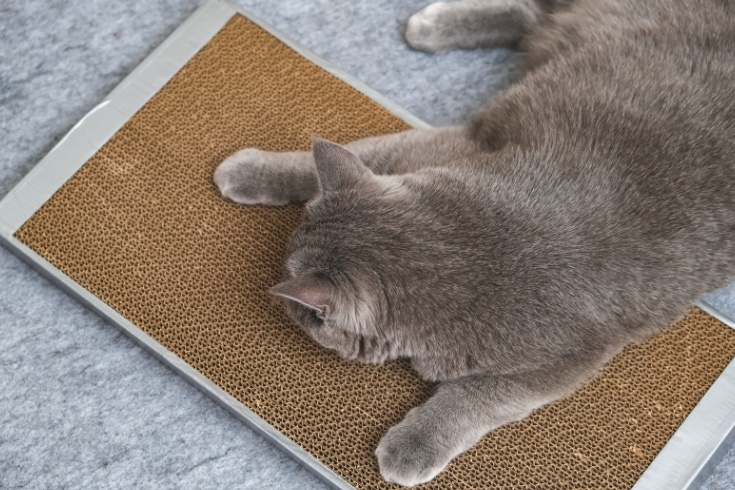
You can redirect your cat’s attention away from your furniture and carpets and provide an outlet for natural behavior by giving your pet a scratching mat or scratching post.
Use Interactive Toys
Part of training your cat and as a positive reinforcement tool can involve the use of interactive toys, such as wands and laser pens.
Encourage Litter Box Habits
No one wants to clean up after a cat toilet accident, so be sure to encourage good litter box habits by keeping the litter clean and fresh, ensuring the box is big enough, and positioning it in a quiet place.
Create A Safe Space
Your cat will be more relaxed and trainable if she has a safe, secure, quiet space to retire to in times of stress. Ideally, that place needs to be away from other pets and noisy kids, in a part of the house that the cat can call hers.
Avoid Punishment
Never punish your cat for exhibiting undesirable behaviors by yelling or swatting at her! That will only make the cat resentful and afraid of you, which will set back your training considerably and damage the bond you’re trying to build with her.
Seek Veterinary Advice

As mentioned previously, if you’re struggling to train your cat and think she might have a physical problem, always seek veterinary advice.
That’s especially important if your cat’s behavior suddenly changes for no apparent reason, as that could indicate an underlying health condition you’re not aware of.
Cat Behavior Training FAQs
In this part of our guide, we answer the most commonly asked questions about cat behavior training.
Can A Cat Be Trained Like A Dog?
Cats can be trained in much the same way as dogs, although because felines are more independent, training might take a bit longer.
Can You Discipline Cats?
The best way of disciplining your cat is by clapping your hands, using an air spray, or raising your voice. Never use physical violence or fear to discipline your cat, as negative methods never work, and you will simply make your cat afraid of you.
How To Become A Cat Behaviorist?
To become a cat behaviorist, you need to have at least a degree in animal welfare or something similar, as well as lots of experience in owning and caring for cats.
Do Cats Understand Praise?
My cats understand praise from the tone of my voice, my actions, and the treats I give them when they’re good.
Do Cats Respond To Negative Reinforcement?
Never use punishment when training your cat. If you yell at or hit your cat, you’ll simply make her afraid of you and resentful toward the training process. In extreme cases, the cat could react aggressively or run away altogether.
Is It Possible To Train A Cat To Behave?
You can train a cat to behave in certain desirable ways and eliminate unwanted behaviors by using positive reinforcement training methods, patience, and plenty of repetition.
In Conclusion
I hope you enjoyed our guide to cat behavior training and the common problems you might experience. If you did, please remember to hit the share button before you go!
Cat behavior training involves teaching your cat and modifying her behavior to respond to your commands, eliminate undesirable behaviors, and behave correctly in particular situations.
Common cat training problems include excessive vocalization, destructive behaviors, urine marking, biting, chewing, and scratching. Using positive reinforcement training methods is the best way to teach your cat to respond to your commands, behave more appropriately, and generally be nicer to be around.
Do you have any cat training tips you want to share? Tell us your secret in the comments box below!